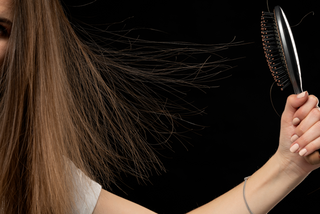The weather is turning colder, leaves are changing color, and hair is...flying? That’s right-- we’re entering hair static season. So what exactly causes hair static? And just as importantly, how can you avoid it? Here’s how to keep your tresses tame this fall and winter.
What Causes Hair Static?
When you were a kid, did you ever rub a balloon over your hair to create static electricity and then watch your hair stick to the balloon and rise as it was lifted away? Or maybe you even had a chance to try a Van de Graaff generator, one of the large silver balls that makes your hair stand on end when you touch it. Static electricity was responsible for both hair-raising experiments. (We’ll see ourselves out now.)
It turns out that the static you experience on an everyday basis in the colder months is the same phenomenon but in miniature. It all comes down to physics. (You didn’t know you were signing up for science class today, did you?)
When the air is cold, and especially when we turn on the heat, humidity is lower, allowing electrons to transfer more easily across dry surfaces, like carpeting, dry skin, and your hair. Friction (think warm hats) can also cause electrons to transfer. Electrons with like charges repel one another, causing your strands of hair to move apart, and voila, static hair.
This buildup of electrical charge is also why you may get a shock when you touch a metal object, like a doorknob. It’s not much fun, and it’s definitely not going to help you have a good hair day. Thankfully, there are several things you can do to avoid or get rid of hair static.
Take Advantage of Ions
Go Natural
Stick to Metal
Add Moisture
Hair static doesn’t have to ruin your fall and winter fun. Just use the above tips, and you’ll have a picture-perfect mane all year long.

